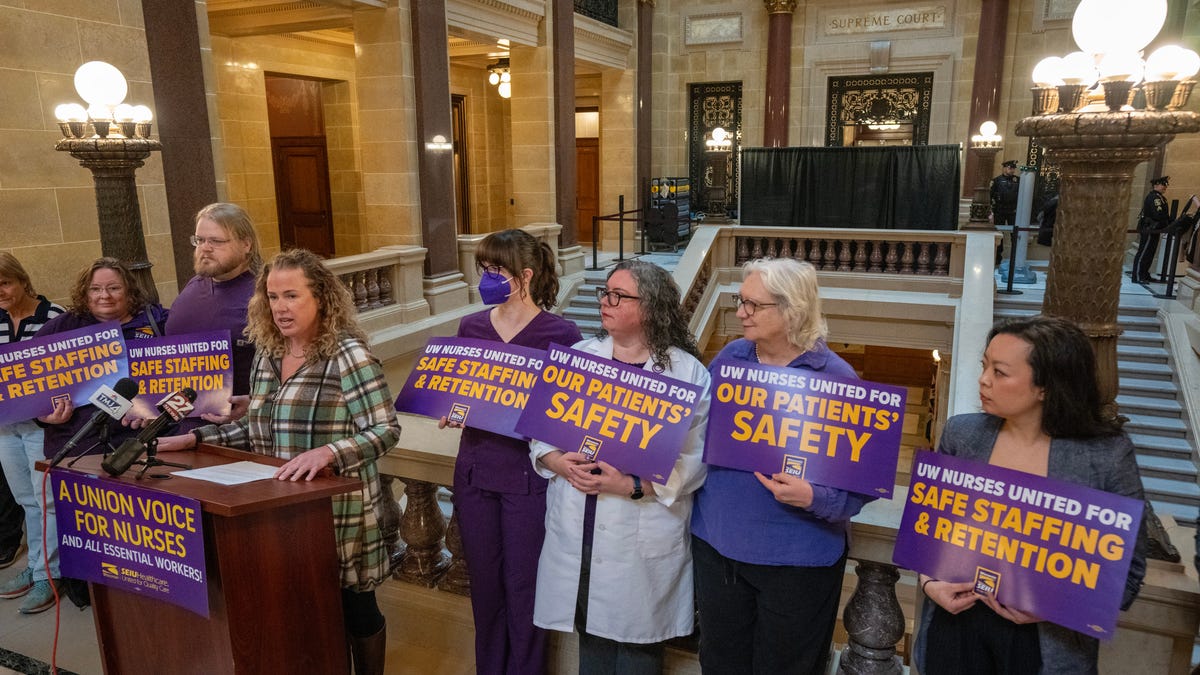Ohio
Tech company behind Kentucky school bus problems had similar issues in Ohio last year

LOUISVILLE, Ky. (AP) — The company behind a disastrous change to a Kentucky city’s school bus routes that resulted in more than a week of canceled classes had similar problems in two cities in neighboring Ohio last year.
Touting its connections to the Massachusetts Institute of Technology, bus-routing vendor AlphaRoute pitched its mathematical models and machine-learning technology as a way of saving money and smoothing out complex bus routes in Louisville, Kentucky, and school districts across the U.S.
But real-world problems often got in the way.
Columbus began running new routes planned by AlphaRoute in fall 2022 after entering into a three-year, $1.6 million contract. But there were problems from the beginning. Most importantly, the district was not able to make adjustments quickly with the company’s software. It decided to pivot mid-year to the software it was previously using from another company, Versatrans, said district spokesperson Jacqueline Bryant.
Cincinnati Public Schools told The Associated Press in an email that it was under contract with AlphaRoute for less than one year, beginning in April 2022 at a cost of $150,000.
“AlphaRoute provided route analysis and made efficiency recommendations. CPS was not satisfied with the results and had to reroute and physically evaluate each stop,” according to the statement.
Several other districts listed as partners on the company’s website said they either no longer worked with AlphaRoute or never were its customers. The school district in Providence, Rhode Island, a listed partner, said it considered the company’s proposal in 2021 but “went in another direction.”
AlphaRoute said in a Tuesday night written statement that it recognized the Kentucky school cancellations have been “terribly disruptive” and that it has had a team in Louisville helping to address them since Saturday.
“We at AlphaRoute have been working alongside the district to fix as many issues as possible as fast as possible, so that service is greatly improved when schools reopen on Friday,” it said.
In Louisville, the transportation changes recommended by AlphaRoute for Jefferson County Public Schools proved disastrous on the first day of school. Some students were not picked up in the morning while others did not arrive home until nearly 10 p.m.
The fiasco resulted in hungry and tired children, angry parents and exasperated politicians. Schools had to be closed to reevaluate the transportation plan, and students will have missed more than a week of school when they begin returning on Friday as part of a staggered reopening. The fallout has included a call from some state lawmakers to explore splitting up the state’s largest school district.
Like other districts, Jefferson County turned to AlphaRoute for ways to increase efficiency and cut the number of bus routes after a nationwide driver shortage left them scrambling for solutions to transport students. The company, based in Waltham, Massachusetts, uses computer algorithms to map out bus routes and stops.
In a March 2021 letter to Jefferson County seeking to justify its use as a single contractor, company co-founder and CEO John Hanlon outlined how his firm could solve some of the “daunting challenges” of a busing system he described as inefficient and one of the most complex in the country, with 65,000 daily bus riders.
Hanlon touted AlphaRoute as the only company capable of both rerouting buses and planning staggered school start times. Superintendent Marty Pollio championed the idea, saying the combination would allow for more efficient use of buses and let teenagers sleep longer so they could be more alert in school.
A researcher who studies automation bias — in which people are prone to overly trusting the abilities of automated systems, from factory robots to ChatGPT — said what happened in Louisville fits into a broader problem with the use of artificial intelligence technology.
Students having to walk long distances to bus stops early in the morning might have been “algorithmically correct” because it satisfied the objectives and constraints of the algorithm under Kentucky law, “but in reality parents would not want their kids walking that far at 6 a.m.,” said Aaron Schecter, a professor of information management systems at the University of Georgia.
Similarly, an algorithm might satisfy its goal of minimizing total routes, to lessen the number of drivers, at the expense of another criterion such as the time it takes to transport students. Schecter said machine-learning algorithms such as AlphaRoute’s are typically trying to optimize an objective and can overlook “worst case” harms even if the average result is satisfactory.
“The underlying principle here is that people were wooed by something that seemed sophisticated, and they trusted that AI would be a magic fix,” said Schecter, who hadn’t evaluated the specific technology used.
AlphaRoute’s Hanlon is the former chief operating officer of Boston Public Schools and has emphasized the company’s origins as a partnership between MIT researchers and the school district.
In a 2019 scientific paper, a team lead by Dimitris Bertsimas, an MIT professor who is also a co-founder of AlphaRoute and its parent company, Dynamic Ideas LLC, said that using an algorithm for selecting the best school start times would empower Boston leaders “to make decisions based not on the political whims of special interest groups but on an objective standard agreed on by the community.”
News articles at the time said the researchers helped Boston cut 50 buses for a savings of $5 million, although transportation officials did have to vet and tweak the routes before they were used.
However, Boston only ever used routing software in a limited capacity and has no relationship with AlphaRoute today, district spokesperson Max Baker said.
In a follow-up paper in 2020, Bertsimas and his team acknowledged that Boston didn’t follow its recommendations for changed bell times and elaborated on a number of routing challenges, from the city’s meandering topography to the equity-minded policies tracing back to racial desegregation efforts of the 1970s. But it said the experiment led it to develop a new software system that it was showing to nearly 30 school districts across 17 states.
Nearly 500,000 school buses nationwide transport 25 million students, said Molly McGee-Hewitt, executive director with the National Association for Pupil Transportation. The driver shortage is a real problem, she said, but one that can be solved by offering competitive pay and benefits and reducing bureaucratic barriers to entry.
“You can’t have world-class schools without world-class infrastructure, and that includes transportation,” she said.
Routing can be complicated, especially in districts that are transporting children across town to magnet schools, charter schools, special needs schools and even private schools, McGee-Hewitt said. Various software vendors have been successfully helping schools manage that challenge for years.
In a news conference Monday, Jefferson County Public School Superintendent Pollio said one significant deficiency was that the recommended routes weren’t accounting for the latest information. He said AlphaRoute gave the district the new routes earlier in the summer, but since then thousands of stops had been added as new students enrolled ahead of opening day or parents requested a different bus stop.
“When stops are added to routes, we did not properly add the time that was needed for a bus driver to complete that,” he said, explaining that those extra minutes were adding up.
“We had some room for error in our former schedule. We do not have room for error now,” he said.
In assessing fault for the opening day fiasco, Pollio has said he’s “not going to put it on the company. … I said it from the very beginning, I take responsibility for it myself.”
_____
Loller reported from Nashville, Tenn. AP Technology Writer O’Brien reported from Providence, Rhode Island.

Ohio
Here’s what won’t make the November ballot in Ohio

COLUMBUS, Ohio — The proposals to overturn legislation overhauling higher education, eliminate property taxes and end qualified immunity will not be on the November ballot, despite advocates trying to get the question to Ohio voters.
Public education advocates have fallen short 50,000 signatures of the needed 250,000 to put a referendum on the Ohio ballot, Youngstown State University Professor Dr. Cryshanna Jackson Leftwich said. She was aiming to repeal Senate Bill 1, a controversial college overhaul bill.
The effort was led by a small grassroots organization made up of mainly Youngstown State professors like Jackson Leftwich. The group had no money, no backing from statewide or national education groups or paid canvassers — which she said was a problem.
Typically, successful coalitions submit hundreds of thousands more signatures, because oftentimes they are invalid. When Ohioans United for Reproductive Rights, the group putting an amendment on the ballot to protect abortion, IVF and contraception, they submitted 300,000 more signatures than needed as cushion room. The group needed around 415,000, submitted 710,000 and ended with about 500,000 valid.
“It shouldn’t take millions of dollars to fight [for] democracy,” she said. “It shouldn’t take millions of dollars for consultants and lawyers for average voting citizens to say, ‘Hey, this is an unjust bill.’”
State Sen. Jerry Cirino, the top Republican on the influential Finance Committee, introduced the legislation.
“It provides for a policy to be established for what I call intellectual diversity, which is very important,” Cirino said. “It means openness to all various thoughts about various issues, which is the opposite of indoctrination — indoctrination is when you expose students to only one train of thought, so a monolithic thought environment. That is not good for students.”
Ohio Gov. Mike DeWine signs controversial college overhaul bill banning DEI
This massive bill focuses on what the Republican calls “free speech,” banning public universities in Ohio from Diversity, Equity and Inclusion initiatives, having “bias” in the classroom, and limiting how “controversial topics” can and can’t be taught. Eliminating DEI would mean no diversity offices, training, or scholarships.
“I believe that will benefit students greatly and produce better students who know how to think and analyze and come to their own conclusions,” he added.
Students and professors from across the state have continued to argue that there is nothing wrong with their education, and they are furious that lawmakers are trying to interrupt their classes.
Ohio House bans DEI, passes education overhaul bill
This is one of the most protested-against bills in recent Ohio history. There were roughly 1,500 people who submitted opponent testimony against S.B. 1, and there were about 30 who submitted in support. Which is why Amanda Fehlbaum, a YSU professor, was shocked when no larger organizations “stepped up” to help them, she said.
The group raised $45,000 in six weeks and collected the signatures without any paid assistance, which was very challenging, Fehlbaum added, emphasizing that larger groups said that a referendum would be “too expensive,” she said.
Cirino told us Thursday that he isn’t surprised that the effort failed, because he said the bill is good policy.
“I think their biggest problem was that this was a group of disgruntled faculty members, mostly from Youngstown State, who are satisfied with the status quo in higher education,” he said. “They couldn’t be more detached from reality in terms of what needs to be done to make Ohio’s Higher Ed the very best we can be.”
But the S.B. 1 repeal wasn’t the only “everyday” group that couldn’t get on the ballot.
The Citizens for Property Tax Reform didn’t submit the signatures they gathered.
“It’s such a huge undertaking,” organizer Beth Blackmarr said Thursday.
Blackmarr helped create a coalition of homeowners in Cuyahoga County, hoping to put a constitutional amendment on the November ballot that would eliminate property taxes.
Ohio citizens working to get proposal on ballot to abolish property taxes
Her team, Citizens for Property Tax Reform, knew they weren’t near the 415,000 they needed. She didn’t have an estimate of how many they collected, nor how much money they raised.
“As naive as we are, we may have underestimated, just a little bit, how big the response was really going to be,” she said. “That’s been quite rewarding, so we’ve asked everybody to keep on trucking and keep going.”
Despite both being grassroots, her situation is different from Jackson Leftwich’s for two main reasons: constitutional amendment proposals can be pushed back to future elections, and she told us a month ago that her proposal didn’t even have to reach the ballot.
“Hopefully, what legislators will do is counter with some legislation of their own,” she told me in May.
And it has worked.
“I’m hoping this does help to push us,” State Rep. David Thomas (R-Jefferson) said when I asked him about the tax amendment.
Thomas leads property tax relief discussions in the House and said that he and the other members heard Blackmarr. Since her amendment, lawmakers have been proposing more property tax relief bills and have passed several in the budget.
“This is a win-win for Ohio,” Blackmarr said.
Strategy has to come into play when getting an issue proposed statewide, she added.
“Is this indicative of the challenges that regular people face when trying to access the ballot?” I asked the professors.
“Ohio makes it as difficult as possible,” YSU’s Education Association President Mark Vopat said, detailing all of the work that must be done to go through the extensive collection process. “I believe that the state has made it as onerous as possible for individual citizens like us, — we’re doing this as a voluntary effort — to actually get some sort of referendum passed.”
For all ballot proposals, campaigns need valid signatures from at least 44 of Ohio’s 88 counties.
For referendums, the total signatures must be 6% of the total votes cast for governor during the last gubernatorial election. This makes the number about 248,092 valid signatures.
For initiated statutes, the total signatures must be 3% of the total vote cast for governor during the last gubernatorial election. This makes the number about 124,046 valid signatures.
For constitutional amendments, the total signatures must be 10% of the total vote cast for governor during the last gubernatorial election. This makes the number about 413,487 valid signatures.
There have been efforts to make this harder, though.
Republican leaders in Columbus are floating the idea of attempting to make it more difficult to amend the state constitution, a proposal that was defeated in 2023 by Ohioans across the political spectrum.
Another fight over majority rule in Ohio? Republican leaders float the idea.
Issue 1 in 2023 would have taken away majority rule in Ohio. The proposed constitutional amendment would have raised the threshold for constitutional amendments to pass from 50%+1, a simple majority, to 60%. It was defeated 57-43%.
The following year, 2024, the Senate GOP moved to increase the amount of counties campaigns must collect from and put more bureaucratic layers on advocates. They wanted to require all groups rallying for a cause that is receiving donations and spending money to register as a political action committee (PAC). This means that groups would have to file disclosures with the government, and it could make it more difficult to collect signatures to get a proposal on a township ballot.
OH House agrees to compromise on Biden ballot fix if ‘anti-democratic’ Senate provisions taken out of bill
Other challenges campaigns can face deal with the political offices they must go through.
Ohio activists are starting to gather signatures to get a constitutional amendment on the ballot that would end qualified immunity — a protection for police and other government officials that prevents citizens from suing them.
State law prevents government officials from being held liable for civil damages unless the victim can prove that the officer violated their constitutional rights, which can be an uphill battle, advocates say.
The Ohio Coalition to End Qualified Immunity has been battling Attorney General Dave Yost to get their summary language approved so that they can collect signatures. He has rejected it eight times, and recently, in short, courts have required him to allow them to move forward.
From their approval, they would have only had two months at most to collect signatures. Although initially hopeful for November, their team told us Thursday that they are now aiming for 2026.
But when it comes to S.B. 1, Jackson Leftwich said this isn’t the end for them, either.
“If we got this on the ballot, we would have overturned it,” she said.
The group didn’t specify if and how they would try again, or just rely on the larger groups in future years.
Follow WEWS statehouse reporter Morgan Trau on Twitter and Facebook.
Ohio
Ohio marijuana law changes stall in Statehouse. Cities are paying the price
Ohio cities with marijuana dispensaries won’t receive tax money until lawmakers agree on changes to Issue 2, which voters approved in 2023
Video: Buying recreational marijuana in Ohio? What it’s like
You can now legally buy recreational marijuana in Ohio. Walk through the process of what it looks like to make a purchase at the dispensary here.
- Ohio is withholding tax revenue from cities with marijuana dispensaries until state lawmakers agree on cannabis and hemp regulations.
- Local governments express frustration over the withheld funds, while state officials claim they lack the constitutional authority to release the money without a specific appropriation.
- The debate over marijuana and hemp regulation will continue in the fall.
Ohio will continue to withhold money from cities with marijuana dispensaries after Republican efforts to change cannabis and hemp laws came up empty.
The two-year budget approved by the House and Senate maintains current funding for municipalities, which is 36% of the tax revenue from adult-use cannabis sales. But lawmakers won’t release that money until they reach an agreement on rules for marijuana and intoxicating hemp products.
Republicans hoped to have a deal on marijuana before the Legislature’s summer break, but it didn’t happen − punting the issue to later this year. Local leaders say that puts them in the difficult spot of trying to fund services without money they were promised.
“What they’re saying is if we can take your lunch money, we will,” said David Kubicki, chairman of Columbia Township Trustees.
Ohio lawmakers reach impasse on marijuana, hemp
As approved by voters in 2023, Issue 2 divides marijuana revenue between local communities, a social equity program, substance use research and administrative costs. The budget keeps local funding in place and directs the rest to Ohio’s general bank account.
Republicans pledged early on to dismantle the social equity program, which aimed to diversify the industry and right the wrongs of cannabis prohibition. State regulators have allowed the program to languish amid uncertainty about its future.
But that’s not the only part of Issue 2 lawmakers want to change.
The House and Senate spent months negotiating over Senate Bill 56, which would revise Issue 2 and govern gray market cannabis such as delta-8. The latest version regulates the gifting of home-grown cannabis, allows up to 400 dispensaries and permits smoking only at private residences and outdoor concert venues.
“We need to specify that they can have more dispensaries, for example, rather than a tightly locked number,” Rep. Jamie Callender, R-Concord, said. “The only way we’re going to drive the price down to be more competitive with other states is to have more dispensaries.”
Senate Bill 56 would also set rules for THC beverages and require intoxicating hemp products to be sold in dispensaries. Gov. Mike DeWine has repeatedly called on lawmakers to address delta-8, saying a loophole in federal law makes it easy for children to buy untested products.
Rep. Brian Stewart, R-Ashville, said there were too many differences among Republicans to reach a compromise before the end of June. Hemp became a major sticking point: Some lawmakers want to put it in dispensaries, while others believe the plan would hurt legitimate businesses selling CBD products.
“If we want to truly protect consumers and make sure these products are safe, we want to make sure we have a legitimate market for them rather than having them go elsewhere,” Rep. Tex Fischer, R-Boardman, said.
What’s next for local marijuana money in Ohio?
Another hang-up: How much money local governments should get.
An earlier version of the budget distributed 20% of the marijuana to cities for just five years. Stewart said Republicans couldn’t agree on a funding level and will resume that debate in the fall.
In the meantime, state officials say they can’t give money to locals because Issue 2 didn’t include a way to spend it. The Ohio Constitution requires an appropriation to release money from the state treasury.
The cannabis industry disagrees.
“It is our belief that Issue 2 was clear about the money going to local communities,” said David Bowling, executive director for the Ohio Cannabis Coalition. “Our members pride themselves in being good community partners in the areas where they live, work and do business. The Host Community Fund is a critical piece of that partnership.”
State government reporter Haley BeMiller can be reached at hbemiller@gannett.com or @haleybemiller on X.
Ohio
Lose power? These Ohio maps show how widespread an outage is, when electricity will return

How ‘battery islands’ could help keep the lights on during severe weather
After destructive hurricanes led to days of power outages in Florida in 2024, Duke Energy is investing in some unique new backup power sources.
The sweltering temperatures around Ohio are hanging around, and that extreme heat has cut power at times to thousands around the state.
Depending on the electrical service in your area, you can check the latest status of your power outage, how widespread the outage is, an estimated restoration time and more. Ohio residents can draw power from FirstEnergy, Ohio Edison, AEP Ohio, Duke Energy, The Illuminating Co., AES Ohio, Cleveland Public Power and Toledo Edison.
Here’s where to find their power outage maps.
FirstEnergy, Ohio Edison, Toledo Edison and The Illuminating Co. power outage map
You can check the power outage map here. You can also report your outage here or reach them by phone about outages at 888-544-4877.
FirstEnergy reminds customers to call 911 immediately if you see a downed power line. Stay at least 30 feet away and instruct others to do the same.
AEP Ohio power outage map
Customers of AEP Ohio can view its power outage map here. You can report an outage here or by calling 800-672-2231.
Duke Energy power outage map
Duke Energy customers can find a map of power outages here. To report an electrical outage, click here or call 800-343-3525.
Duke’s map also has the ability to show outage histories and a current summary of known issues and how many customers are impacted.
AES Ohio power outage map
You can check the power outage map here. You can also report your outage here or reach them by phone 24/7 about outages at 877-468-8243.
Cleveland Public Power outage map
Cleveland Public Power customers can view the outage map here. To report an outage, click here or call 216-664-3156.
How to check other Ohio power outages
For any companies not listed above, check our power outages database that aggregates power outage information from more than 1,000 companies nationwide.
-

 Arizona1 week ago
Arizona1 week agoSuspect in Arizona Rangers' death killed by Missouri troopers
-

 Business1 week ago
Business1 week agoDriverless disruption: Tech titans gird for robotaxi wars with new factory and territories
-

 Business1 week ago
Business1 week agoProtesters are chasing federal agents out of L.A. County hotels: ‘A small victory’
-

 Technology1 week ago
Technology1 week agoMeta held talks to buy Thinking Machines, Perplexity, and Safe Superintelligence
-

 Technology1 week ago
Technology1 week agoSpaceX Starship explodes again, this time on the ground
-

 Technology6 days ago
Technology6 days agoSamsung’s Galaxy Watch 7 has returned to its lowest-ever price
-

 Movie Reviews1 week ago
Movie Reviews1 week ago‘8 Vasantalu’ movie review: Phanindra Narsetti’s romance drama is ambitious but lacks soul
-

 Politics6 days ago
Politics6 days agoTrump demands special prosecutor investigate 'stolen' 2020 election, loss to Biden



















